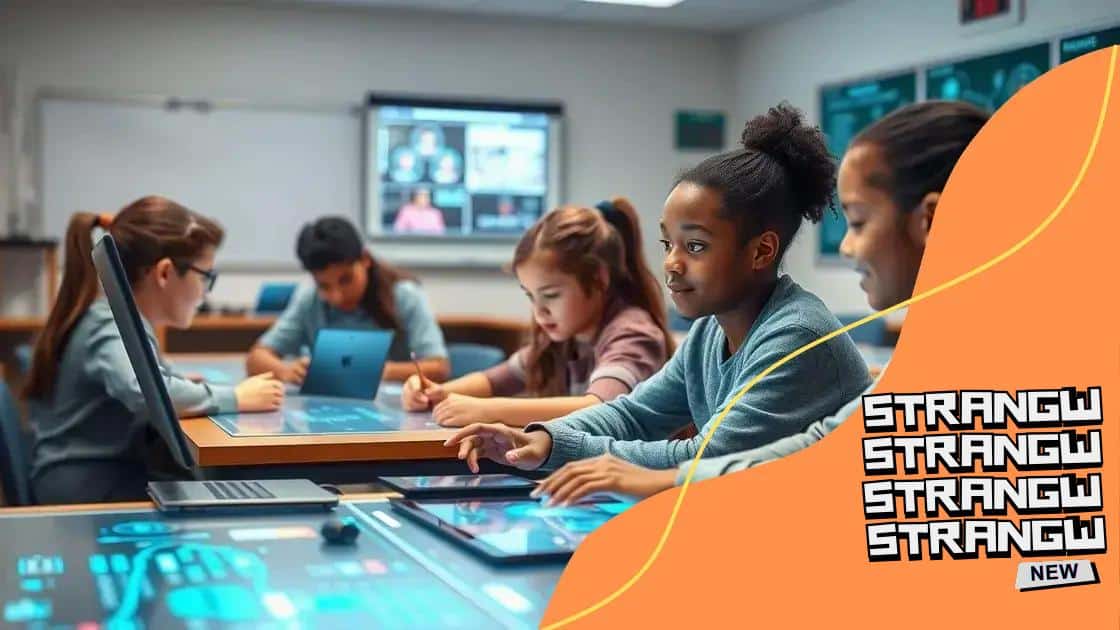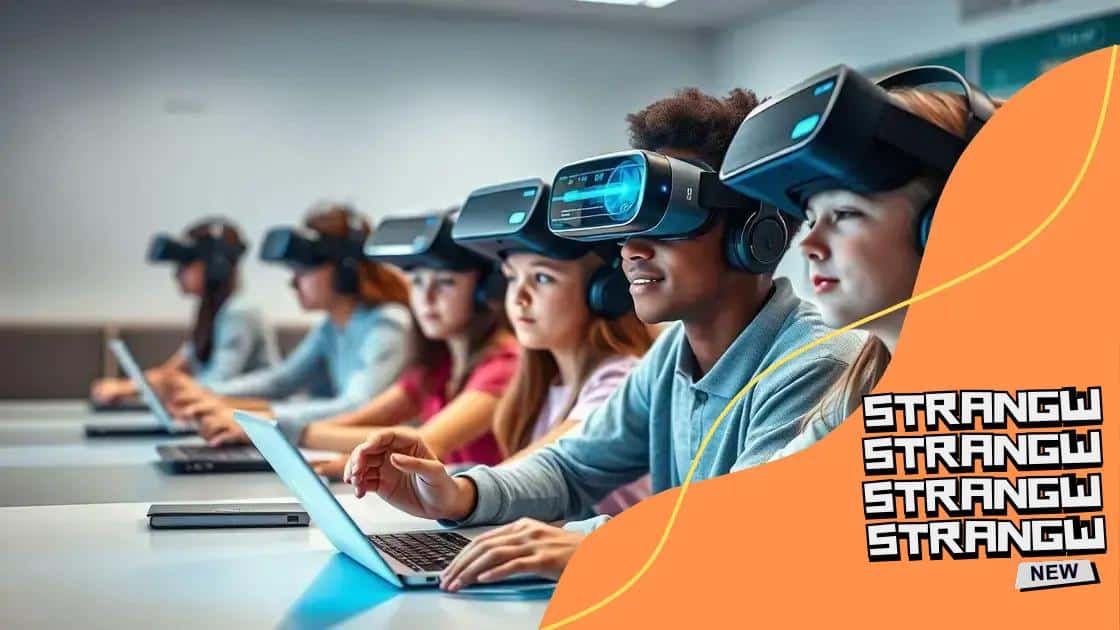AI in special education tools: transforming learning

AI in special education tools enhances personalized learning, fosters engagement, and addresses accessibility, allowing educators to meet diverse student needs effectively.
AI in special education tools is opening exciting avenues for learners with disabilities. Imagine a classroom where each student’s unique needs are met through tailored technology that enhances their learning experience. Curious about how this works? Let’s dive in!
Understanding AI in special education
Understanding AI in special education is essential for enhancing learning experiences for students with disabilities. These advanced tools can adapt to the specific needs of each learner, making academic paths smoother and more accessible.
AI technologies offer personalized learning experiences that cater to individual strengths and weaknesses. By leveraging machine learning and data analysis, educators can gain insights into how students learn best. This means every child can benefit from teaching methods tailored to their unique requirements.
Types of AI Tools in Education
There are various AI tools that are used in special education, each designed to support different learning styles and needs. Some of them include:
- Speech recognition software – Helps students with speech difficulties to communicate effectively.
- Interactive learning platforms – Adapts lessons based on student performance in real time.
- Assistive technologies – Provides tools that aid in writing, reading, and comprehension.
In addition to these tools, AI can facilitate data-driven decision-making for educators. Teachers can track progress through dashboards, which showcase student improvement over time. With constant assessments, adjustments can be made quickly to address areas where students may be struggling.
Benefits of AI in Special Education
Many schools are embracing AI to unlock the full potential of all learners. The primary benefits include:
- Improved engagement through personalized activities.
- Increased independence for students with disabilities.
- Enhanced collaboration between teachers and parents through shared progress data.
By focusing on individual abilities, AI not only helps students learn but also builds their confidence. Students can engage with materials in ways that suit them, often leading to better outcomes and a love for learning.
AI in special education is not just about technology; it’s about creating a more inclusive environment. As schools continue to integrate these tools, the future looks promising for students who need additional support.
Key benefits of AI tools for students
AI tools bring numerous benefits for students, especially those who require special education. These technologies are designed to enhance learning experiences and support diverse needs. With the help of AI, students can achieve their goals more effectively.
The practical advantages of AI tools are significant and wide-ranging. These tools not only address educational challenges but also foster independence and confidence among learners. Let’s explore some key benefits in detail.
Personalized Learning
One of the most important benefits of AI tools is their capability for personalized learning. Each student has a unique way of understanding information, and AI helps cater to these differences. Through data analysis, AI systems adjust lessons based on individual performance, helping students learn at their own pace.
Enhanced Engagement
AI tools can also boost student engagement. Engaging with interactive applications can make learning more appealing. Students are more likely to participate actively when the learning process is enjoyable and suited to their interests. This leads to better retention of knowledge.
- Gamification offers fun, game-like experiences that turn education into an enjoyable activity.
- Real-time feedback allows students to see their progress immediately, encouraging them to keep trying.
- Adaptive challenges provide tasks that match the student’s skill level, ensuring they are neither too easy nor too difficult.
Not only does this increase enjoyment, but it also supports a deeper understanding of various subjects.
Accessibility and Inclusivity
AI tools significantly enhance accessibility in education. They address barriers that students with disabilities may face. For instance, those with reading difficulties can use text-to-speech technology, making written content more approachable. This inclusion empowers all students to participate fully in learning.
By promoting accessibility, AI helps create an educational environment where everyone can thrive. The focus shifts from traditional methods that may not suit everyone to personalized approaches that recognize and meet individual needs.
Ultimately, AI tools are reshaping the educational landscape, allowing students to grow and succeed in ways that were previously unimaginable.
Innovative AI applications in learning environments

Innovative AI applications are transforming learning environments, making them more dynamic and effective. These advancements are especially beneficial in classrooms, where diverse needs must be met. AI helps tailor educational experiences that foster both engagement and understanding.
One notable example is the use of adaptive learning technologies. These systems adjust the learning material based on the student’s performance in real time. As learners progress, the difficulty increases to challenge their abilities while ensuring they receive appropriate support.
Virtual Learning Assistants
Another exciting application is the development of virtual learning assistants. These AI-driven tools can help students throughout their educational journey. They provide on-demand support and resources, guiding learners through difficult concepts and answering questions in real time. This accessibility can greatly reduce anxiety and improve comprehension.
Augmented and Virtual Reality
Augmented reality (AR) and virtual reality (VR) are also making waves in education. These immersive technologies allow students to explore subjects in a hands-on way. For example, a student studying biology can virtually dissect a frog or explore the human body in 3D. This level of interactivity can enhance understanding and retention of knowledge.
- Interactive simulations enable students to experiment and learn from their mistakes in a safe environment.
- Collaborative tools allow students to work together, even when they are not in the same location, promoting teamwork.
- Gamified learning engages students through game-like elements, making lessons more fun.
These technologies also foster a sense of agency in learners, encouraging them to take ownership of their education. With AI, students can explore their interests and work at their own pace, leading to deeper learning experiences.
Moreover, AI applications in learning create opportunities for teachers to personalize their instructional methods. By using data collected from AI tools, educators can understand how their students learn best and adjust their teaching strategies accordingly.
Challenges in implementing AI in special education
Implementing AI in special education presents several challenges that educators and institutions must navigate. While the potential for improved learning outcomes is significant, various obstacles can hinder effective adoption. Understanding these challenges helps create effective strategies for success.
One of the most pressing issues is the cost of technology. Many schools struggle to secure funding for AI tools, including necessary infrastructure and training. Limited budgets often lead to a lack of resources needed to purchase and maintain advanced systems. This can create disparities between institutions that can afford such tools and those that cannot.
Training for Educators
An additional challenge involves providing adequate training for educators. Teachers need to understand how to utilize AI tools effectively in their classrooms. Without proper training, the potential of these technologies may go untapped. Furthermore, educators may feel overwhelmed by the rapid pace of technological change, leading to reluctance in adopting new methods.
Data Privacy Concerns
Another concern is related to data privacy. The use of AI often involves collecting sensitive information about students, including their learning patterns and personal details. Protecting this data is paramount to prevent misuse and ensure compliance with regulations. Educators and schools must have clear policies in place to safeguard student information.
- Establishing guidelines for data use and storage is crucial for maintaining trust.
- Regular audits of data handling practices can help identify potential vulnerabilities.
- Transparency with parents and students about how their information is used can foster a more secure environment.
Additionally, integrating AI tools into existing curricula can be difficult. Many educators are accustomed to traditional teaching methods and may struggle to incorporate new technologies. It’s vital to create a seamless integration process, combining AI with established practices to enhance, rather than disrupt, the learning experience.
As we move forward, it’s clear that addressing these challenges is essential for successfully implementing AI in special education. By tackling issues such as funding, training, data privacy, and integration, schools can maximize the benefits these tools offer for all students.
Future trends in AI for inclusive education
The future of AI in inclusive education looks promising, with several evolving trends that can enhance learning for all students. As technology advances, the potential for AI to integrate into educational systems grows, offering more personalized and effective solutions.
One key trend is the rise of predictive analytics. By analyzing data from various sources, AI can forecast student performance and identify at-risk learners early. This allows educators to intervene before challenges escalate, providing timely support to those who need it most.
Learning Assistants
Another exciting development is the expansion of AI learning assistants. These tools will become more sophisticated, providing tailored support for individual students. They can adapt to a child’s learning style and pace, helping to keep them engaged and motivated. For example, AI can suggest resources that align with a student’s interests and strengths, making learning more relevant.
Integration of AR and VR
The integration of augmented reality (AR) and virtual reality (VR) in classrooms will also expand. These immersive technologies offer unique experiences that can enhance learning. For instance, students can take virtual field trips or explore complex concepts through interactive simulations. This hands-on approach makes subjects come alive, catering to different learning styles.
- Accessibility features will be enhanced, ensuring all students can benefit from these technologies.
- Collaboration tools will become more robust, allowing students to work together seamlessly, regardless of their location.
- As AI continues to evolve, customized educational content will be readily available, meeting the needs of diverse learners.
The development of AI in inclusive education is not only about technology; it is about fostering an environment where all students feel valued. By focusing on accessibility, engagement, and personalized learning paths, AI can empower every learner to succeed, regardless of their challenges.
As we look to the future, it is clear that the integration of AI technology in education will continue to evolve. This will lead to innovative solutions that enhance the learning experience for all students.
FAQ – Frequently Asked Questions About AI in Special Education
What are the main benefits of using AI in special education?
AI provides personalized learning experiences, enhances engagement, and supports accessibility, making education more inclusive for students with diverse needs.
What challenges might schools face when implementing AI?
Schools may encounter challenges such as high costs, the need for proper training, and ensuring data privacy to protect sensitive student information.
How can AI tools help teachers?
AI tools can assist teachers by providing insights into student performance, helping to tailor instruction to individual needs, and offering resources for lesson planning.
What future trends should we expect in AI for education?
Future trends include the use of predictive analytics, more sophisticated learning assistants, and the integration of augmented and virtual reality into learning environments.





